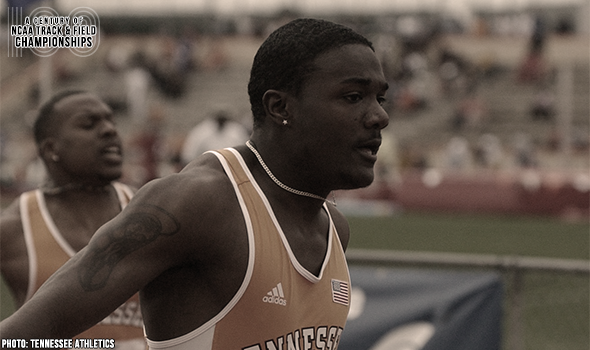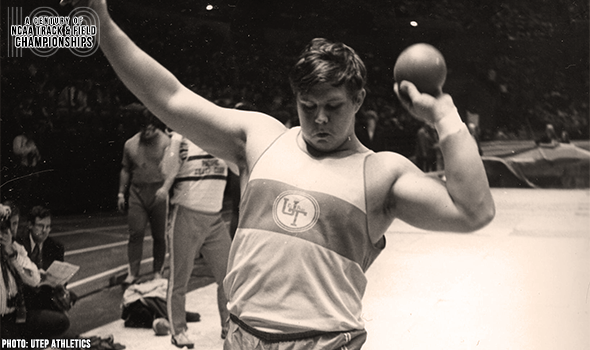
The Tie Goes To The Buckeye
Ties – and sometimes breaking them – were common for Dave Albritton of Ohio State.
But there was no breaking any of the ties in Albritton’s three-straight NCAA high jump victories, and his first in 1936 was historic as he and Buckeye teammate Mel Walker became the first Black athletes to win the event.
That duo was part of an amazing Ohio State team in 1936: They contributed two of the record seven NCAA titles the Buckeyes won that year, joined by Jesse Owens with four (100, 200, 220 hurdles and long jump), along with Charlie Beetham in the 800 meters. No program has matched that number of champions in one NCAA meet.
However, the 1936 NCAA Championships was bittersweet for the Buckeyes, whose 73 points made them the highest-scoring runner-up team in meet history (6-place scoring system). The winning squad was powerful Southern California with 103⅓ points. The bittersweet part was that just a week earlier, Ohio State tied the Trojans in a dual meet when only wins counted, 7½-7½ – the fraction coming in the high jump, where Albritton tied USC’s Delos Thurber.
Albritton’s level of tying made a major leap a month later. A week after finishing third at the AAU Championships (on a tiebreaker), Albritton clinched a spot on the Olympic team in a brand-new stadium at Randalls Island, New York, by – you guessed it – tying Cornelius Johnson of Compton Junior College – who had won the AAU meet – as both cleared a world-record 6-9¾ (2.08m). That tie was not broken.
At the Berlin Olympics, Johnson led a 1-2-3 U.S. sweep, with Albritton earning the silver medal over Thurber’s bronze on a jump-off. Johnson and Albritton thus became the first Black athletes to medal in the Olympic high jump.
In the 1937 NCAA Championships, another Buckeye was favored – but this time it was Walker after sweeping the indoor and outdoor Big Ten titles over Albritton (and setting a world indoor best of 6-9¾ as well). Albritton came through, though, tying Colorado’s Gil Cruter for the win – Thurber was third on a tiebreaker as all three cleared 6-6¼ (1.99m). Walker, a senior, finished fourth but later in the summer raised the world record to 6-10¼ (2.09m).
Albritton and Cruter returned in 1938 as the meet record – 6-7¼ (2.01m) from 1926, then the oldest on the books – was battered like never before or since. In all, six men equaled the old standard as two – Albritton and Cruter – broke it with 6-8¾ (2.05m) clearances and tied yet again as neither succeeded at attempts at a possible WR of 6-10⅜ (2.09m).
Post-collegiate success followed for Albritton, as he won five AAU national titles – the last in 1950 at age 37. Ten years after that, Albritton was elected to the Ohio House of Representatives, serving six terms and becoming the first Black person to chair a House committee in 1969.
The NCAA and collegiate track & field will mark a momentous milestone in the spring of 2021 -- the 100th anniversary of the NCAA Championships and with that, the NCAA Track & Field Championships. In June 1921, the University of Chicago hosted the first track & field championships in NCAA history.
This point can’t be emphasized enough: Not only was the event the first for NCAA track & field, but the first championships for any sport under the sponsorship of the NCAA.
To celebrate, over each of the next 365 days, the U.S. Track & Field and Cross Country Coaches Association (USTFCCCA) will celebrate moments, student-athletes, and coaches that have made a century’s worth of championships special. From humble beginnings to important historical milestones to the modern-day, collegiate track & field has evolved with the American society.
The 2021 edition of the NCAA Division I Outdoor Track & Field Championships begin with preliminary round action on May 27-29 in Jacksonville, Fla., and College Station, Texas. The championships final site and culmination of the celebration is slated for June 9-12, 2021 at the newly rebuilt Hayward Field in Eugene, Ore.

Providence’s Smith Left Field In The Dust
Kim Smith won the 5000 meters at the 2004 NCAA Division I Outdoor T&F Championships by 36.04 seconds in 15:48.86 for the largest margin of victory in meet history.

Gatlin Doubled Up In Back-To-Back Years
Justin Gatlin completed back-to-back 100-200 doubles at the NCAA DI Outdoor T&F Championships in 2001 & 2002. He went 10.08/20.11 & 10.22/20.18 in those respective years.

UTEP’s Hoglund First To Crack 70-Foot Barrier
Hans Hoglund was the first man to touch the 70-foot barrier in the SP at the NCAA DI Outdoor T&F Championships. He also won by more than 4 feet with his 21.33m (70-0) heave in 1975.

LSU’s Hobbs Couldn’t Be Caught In 2018
Aleia Hobbs anchored LSU to a 4×100 relay MR of 42.25 & then doubled back to win the 100 by 0.23 seconds at the 2018 NCAA DI Outdoor T&F Championships.

Michael Johnson Had 1990 NCAAs To Remember
All eyes were on Michael Johnson of Baylor in the 4×400-meter relay at the 1990 NCAA Division I Outdoor Track & Field Championships.

Riley Completed Unprecedented Double In 2012
Andrew Riley completed the only 100-110H double in NCAA DI Outdoor T&F Championships history in 2012. Riley won the 100 in 10.27 & then captured the 110H crown in 13.53

Leatherwood Rolled To Back-To-Back 400 Titles
Lillie Leatherwood won back-to-back 400-meter titles at the NCAA Division I Outdoor T&F Championships in 1986 & 1987. She set a meet record of 50.90 in that second year.

Iowa’s Jones Made Distance History
Charles “Deacon” Jones set a meet record in the 2-mile at the 1957 NCAA Outdoor Track & Field Championships with his time of 8:57.6.

Locke Doubled Up On Sprint Titles In 1926
Roland Locke entered the 1926 NCAA Outdoor T&F Championships as the WR holder in the 220. He left with the meet record in that event (20.9) & also won the 100 in 9.9.

McLain Bounded To All-Conditions TJ Best
Erica McLain won the triple jump at the 2008 NCAA DI Outdoor Track & Field Championships by nearly two feet! McLain bounded to an all-conditions meet best at 14.60m (47-11).

